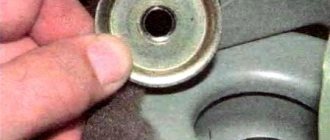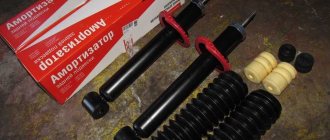Hello, dear friends! Today we will talk to you about such a topic as tinting rear lights. To be more precise, I will tell you what methods can be used to perform such a procedure, how legal it is and whether you should be afraid of fines.
In fact, this procedure did not become popular in 2017 and certainly not in 2022. But now I’m increasingly hearing questions about whether it’s legal to do it yourself.
Some argue that tinting is completely prohibited. And those who try to tint the optics with red film will immediately receive a huge fine or even lose their license for a whole year.
It is necessary to dispel some common myths and tell everything as it is. Let's talk both about the potential fine and about ways that allow you to tint the rear lights of your own car with your own hands without unnecessary problems.
Why tint the taillights on your car?
There may be several reasons, it all depends on the condition of the lanterns, their color and other features. Most often they are tinted for the following reasons:
- Improved appearance. After pasting, the back part is refreshed and looks much more attractive. The effect is especially noticeable on old lanterns, the surface of which has faded, become matte or covered with numerous scratches. It is also easy to hide minor defects - chips, cracks, etc.
Many types of films only slightly darken the lights, making them brighter and more expressive. - Change of stylistic design. By tinting you can give the car a different look, in some situations this is the only way to improve it, since new lights are expensive.
You can quickly change the design of the rear without having to buy new lights. - Elimination of traffic violations . This mainly applies to American cars, in which the brake light may be orange. This is a violation of the rules, but the problem can be solved by sticking a red film on the entire surface or part of it, and it must be dark enough to provide a red color.
- Protecting flashlights from damage . The film not only protects the surface from scratches, but also prevents the formation of cracks even when hit by pebbles. Exterior finishing significantly increases strength, which is important for those who travel a lot on low-quality road surfaces.
Some types of tinting are almost invisible, as they simply refresh the color of the headlights.
What's the fine?
The fine for tinted light fixtures in our case will be 500 rubles, and in very rare cases it may be limited to a warning. This is provided for by Part 1 of Article 12.5 of the Code of Administrative Offenses, which prescribes punishment for driving a car in the presence of malfunctions listed in the Basic Provisions of the Traffic Regulations.
The logical chain here is simple: the Code of Administrative Offenses refers to the Traffic Regulations Appendix, and the latter, in turn, to the Technical Regulations. In fact, if the safety regulations for wheeled vehicles are violated, then the traffic rules are also violated.
Such a fine can be paid with a 50% discount within 20 days after the decision is made or even later in some cases if this deadline is missed.
Can I avoid a fine if I fix it on the spot?
No. Alas, eliminating the condition leading to the violation on the spot, if possible, is the responsibility of the driver, and it does not affect the fine in any way.
The point here is that, again, traffic rules oblige (clause 2.3.1) the driver to ensure that the vehicle is in good condition on the way. This means that if a malfunction is detected, you are obliged to correct it in any case. But the very fact of the violation - driving the car in the presence of such a malfunction - has already taken place and was recorded by the traffic police inspector, therefore the fine is justified.
What is needed for tinting
To tint rear lights with film you will need a certain set of materials and devices. Without them, you should not start work, as you will not be able to achieve a good result. The most commonly used is the following:
- Film for tinting. It is better to buy a special version suitable for headlights.
- Microfiber cloth or any other lint-free cloth. It is important that even small fibers do not remain on the surface, as they will worsen the gluing result.
- Degreasing composition . This can be either a special version or alcohol or compositions based on it. Some types of solvents can be used, but they should be used with caution; some will dull the glass.
- Construction hair dryer . Allows you to warm up the film and improve its fit in difficult areas. Instead, you can use fairly powerful household options with a narrow diffuser, which also heat the surface well.
- Construction or stationery knife for neat and precise cutting.
- Rubber spatula . Special small-sized options that do not damage the film are best suited. Most often they are sold in the same place where the tint film is sold.
High-quality film ensures perfect results.
Reviews
I read about the fine for tinting with varnish. After seeing the amount, I decided to immediately change my mind to film. I made it lighter just to be sure. It turned out beautifully and no one can mess with anything. I’ve been driving like this for two years now (I changed it once because of hail) and no one stops me.
Never use nail polish during training. I tried it more than six months ago. The first traffic police officer stopped and showed me. I had to pay the fine, then go to the service center and change everything to film. I hope there are no people here with a similar story, if there are, then my condolences.
Great experience in this topic. The paint and varnish are very bad. If you want to drive with varnish, you will have to give money to each traffic cop. After I realized this, I began to use film. Fortunately, there are many of them in services. I also improved the brightness of the headlights themselves so they wouldn’t bother me.
Source
Advantages and disadvantages
This solution has both advantages and disadvantages. It’s worth taking them apart to decide whether it’s worth doing the work yourself or not. The main advantages are:
- You can literally transform your car and refresh your headlights in just a few hours. Moreover, if you choose the appropriate tint color, they will be almost the same as from the factory.
- The film masks cloudiness, minor scratches and damage well.
- The protective layer increases the resistance of glass or plastic to impacts and damage.
- The work can be done either by removing the lights or directly on the car.
- If necessary, the film can be quickly removed; it is best to preheat it with a hairdryer.
The film is easily removed after heating.
There are also disadvantages, they are:
- High-quality film is quite expensive. And cheap varieties quickly lose their attractive appearance - the surface becomes covered with small scratches.
- The skill of pasting is not difficult, but without experience problems may arise. Accuracy is important here.
Cheap film does not fit well on curves and often leaves wrinkles on the surface. - Headlights with complex shapes are much more difficult to paste over, especially if they have a lot of protrusions or bends.
When pasting, it is advisable to make a cutout opposite the reversing lights so as not to darken it.
Passing a technical inspection
If there are tuning elements on the light devices in the front part, the car owner may have difficulties with undergoing maintenance. This procedure also includes checking the functionality of the devices.
When changing the lighting parameters of lighting devices, violations are considered as “undesirable design changes.”
A technical inspection with tinted headlights is refused in the following cases:
- modified shape of lighting fixtures;
- malfunctions;
- contaminated surface;
- lack of snow diffuser;
- the presence of parts that slightly cover the lighting fixtures;
- more than 1/3 of the total number of diodes are faulty.
How to choose a tint film
To ensure a good result that will last for a long time, you need to take a responsible approach to the choice of film. It depends on appearance and strength, so it’s worth remembering a few tips:
- Only special material intended for headlights and lanterns is used. You should not use film for windows or car glass; it is not strong enough.
- Color is determined individually. But don’t go to extremes and choose dark materials; they don’t look the best, plus they distort the colors of the turn signals and brake lights.
- It is better to select options from the middle or high price segment. Cheap films are of appropriate quality and are often damaged during operation.
What is it for
Headlight tinting is often used on sports cars to increase their aggressive appearance. Owners of civilian cars darken not only the front, but also the rear optics, using varnishes and films.
There are several options for upgrading headlights:
- Disassembling parts, painting the mask, as well as accompanying elements in black or car tone.
- Covering the outer part of the glass with transparent vinyl film.
- Painting the part with a special varnish for headlights.
In the case of varnish, dismantling the headlight is not required, nor is disassembling it into components. No tools or special wrenches are needed for pasting. Before applying the varnish for tinting, the working surface is prepared, but this does not take much time.
Tinting process
It is best to remove the lights before starting work to ensure easy access to all elements and simplify work. It is worth sticking them on the car in cases where it is not possible to remove them or it causes many difficulties. Instructions for carrying out work:
- Before tinting the lights, you need to clean the surface thoroughly. There should be no dust on it. At the end, the glass or plastic is degreased with any suitable composition. If there were cracks, you can carefully seal them with special means.
- A small piece of film is cut out with a margin on the sides so that in case of displacement there is enough material for work. She tries to make sure everything is okay.
- The protective layer is removed from the film and pasting is carried out according to the instructions, which are on a separate sheet of paper. It's simple - the material is gradually glued and smoothed with a spatula. On bends and difficult areas, the film is heated with a hairdryer to improve flexibility. But you don’t need to be too zealous - if you overheat it, folds will form.
- It is necessary to smooth out section by section, expelling the air. The material is slightly bent at the edges, after which the excess is cut off with a construction or stationery knife.
You can clearly see the instructions in the following videos.
Tinting taillights with film is not difficult if you understand all the details of the process and carry out the work carefully and slowly. The quality of the material is of great importance; if it is good quality, it fits and levels out much better.
How to apply paint or varnish with your own hands?
If you decide to tint the headlights using varnish, you will first need to purchase a special product. It is recommended to give preference to a tinting varnish that is easy to use. Its price may be high, but the result will be better, and one can will be enough.
Toning is carried out in several stages. First of all, you should remove the headlights so that the product lays more evenly. You need to take into account that they will need to be installed back, and you need to be able to do this. The next step is degreasing the surface of the headlights; this will require either alcohol or a special product. After the procedure, you need to let the coating dry.
It is recommended to do tinting yourself in a ventilated, well-lit room or in the fresh air on a bright, but not sunny day. Air humidity should not be high.
Before spraying, you will need to shake the can, then you can apply the paint in a thin and even layer. After this, you need to let the headlight dry, but no specks should get on it. Then you need to apply one or more layers, without exceeding the light transmittance standards. When the headlights are dry, they need to be polished to a mirror shine and installed back on the car.











